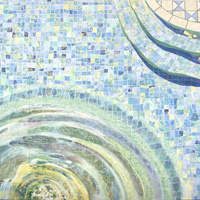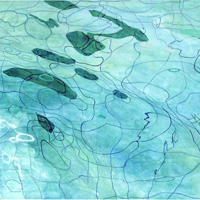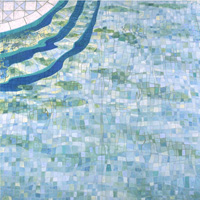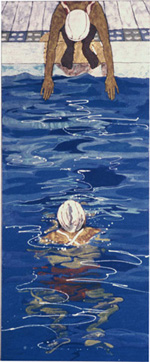First of all, could you explain why you became interested in painting ?I had a great desire to express myself, so the tool of expression for me was either oil painting or traditional Japanese painting, whichever was best suited for me. |
 “Glittering” 2005 |
What was your understanding of the concept of Japanese painting at that time?First, I consider traditional Japanese painting to be done sitting on a floor in the traditional Japanese fashion. My conception of ordinary Japanese painting was that of the gilded portable folding screen often seen in schoolbooks and materials introducing Japanese history. (Laughs) I also took lessons by correspondence schooling through a preparatory school in Tokyo and, during the summer holidays, I participated in seminars in Tokyo and the teacher brought the students from the province to the Art Museum where I became familiar with the paintings by Mr. Heihachiro Fukuda and Shinsen Tokuoka. These paintings were wonderful and impressed me. My attention went to the caption under a painting which said “this painting is done with the powder from rocks.” This was my first introduction to Japanese painting. So, it was as a third-degree high school student, that I made the decision to study Japanese painting. After that I went to a preparatory school and had a time of suffering as I failed, over a period of three years (Laughs), the entrance examination to the art university. |
 “Relaxing Mood” 2005 |
Was your goal to enter the national art university?Yes, it was, but I had problems during the examination, as I would always get nervous. In the preparatory school they taught us the skills for passing examinations and which made me blind to see the object straight and I often became nervous and my self-confidence was destroyed. Looking back, that three years of struggle is a valuable treasure for me, and, without that struggle, I cannot imagine how I might stand at the present time. |
|
So, you succeeded in entering Tama Art University?Yes. When I entered Tama Art University, I had really not decided to become a professional artist/painter, but had just dreamt of being a bride, the mother of a family. As a senior, I worked as an art assistant for the theater, designing stage sets for plays and I was fully compliant with the requirements, but I came to think that that art was not suitable for me because the type of expression was not really personal. I became involved in designing costumes for theater presentations and I did all the planning myself, from the beginning to the end, within budgets and according to the requests of the directors. Although, I was successful, I found that this was not satisfying, so I decided to go back to painting and felt that, if I could not find my own way, I should just quit painting. During this time painting became interesting for me and I decided to become an aspirant in the Art University or to enter a public art contest. What followed was most important for me. The professor for my course commented kindly “you have failed the entrance examination three times and an excellent company only hires, as employees, graduates from the University who have failed twice, and usually a company would not accept you. But I will recommend you, as you have an excellent attitude and a serious desire to be successful as a professional artist, but I must caution, you may not be successful and the endeavor to be a professional artist is not an easy life. I’d like to recommend to you that you consider painting as a hobby and, although I will provide you with the job placement recommendation, I must reinforce the idea that many people cannot achieve the aim of being a professional artist.” Following these comments, I decided not to follow his advice, because I really had a very strong desire to express myself, and I did not want to bring myself to regrettable situation, life is only one time for everyone, isn’t it? (Laughs) |
 “Water – Relaxing Mood” 2004 |
As a career choice for a young person, choosing to become a professional painter may sometimes be quite a gamble?At the time I felt that people who saw my works may feel nothing but that, if I continue, at some point people will draw feeling from my works. I continued to draw every day as though my works were to be a diary .If the paintings can form origin of Japanese perspective as“Rakuchu Rakugaizu buyobu,”( a folding picture), and if I could draw my life by myself, I did believe that my life and works may harmonize and create own works. |
|
Today the trend in the art world is towards the most modern art and these works created by harmony of actual life and painting are not receiving the same attention as they had in the past. Do you agree?If we look at the trend in art from the point of view of “progress,” most artists may be struggling to create art on the most advanced frontiers of art. Some artists can do this without thinking or serious struggle. I think that the most advanced art is being promoted by the media and the media really does not promote a variety of arts. On the other hand, there is still in need for creating a “real art” as a reflection of real-life and not art merely reflecting sensationalism or commercialism. |
|
I think that painting is a reflection of how a painter sees the world. If 100 painters exist, 100 views of the world exist. Therefore, if we categorize or symbolize painting, it may not be the perfect formulation. Painting is not so much a formality or a method or a tool, but individual view itself. For example if an artist moves a vertical line to the horizontal position, this activity may reach some people but not others. Even such a small change may affect the opinions of viewers. Changing the views creates a dynamism and enhances communications. Do you agree?Yes, I do.What I like most about painting is that I believe I can communicate through it. At one time, I gave a lecture and noted that there are many people who write poetry and literature who either are not poets or not novelists. Through painting, there are gaps in communications in life which are filled by this mode of communications. I noted this in my lecture and some people in the audience sent me letters saying that they understood my point and felt the same way. Conversation is one mode of communication but the visual arts is another. We can communicate with our paintings, as I have recognized when I stood in front of paintings by Mr. Heihachiro Fukuda and Mr. Shinsen Tokuoka. I note that both of these gentlemen convey strong messages and the communication is effective. |
|
It means that we are sensing a reality from the form which the eye receives from the drawn image? I note that I always feel a sense of reality when viewing your works.Well it is not theory that enables me to paint, but, in fact, there is a great deal of hard work in creating images. For example my works of the “Surface of Water” is created from quite a large number of sketches. |
|
Is your works “surface of water” one that was done a long time ago?Yes. I started painting it in the middle of 1980s. At that time, I lived in an apartment near a large pond “Zenpukuji” which has a history and features similar to the forest of |
|
This is the scene of someone just about to jump into the pool?Yes. It seems that the white line in the picture impressed my teacher. It was a bit like decorating a cake with cream stripes. I squeezed a plastic bag stuffed with white paint and drew the line. She always mentioned it when we met. In late 1980s, I spent quite a bit of time studying as how best to convey the texture of the surface of the water. But other artists had drawn water surfaces based upon photos therefore I didn’t want to imitate others. I was looking for my own way. My creation is from the material which is in front of me. I feel that is the only way to paint; through observation. This observation still continues. In the initial sketches, I had just put blue glue on canvas. It was not really a good representation of the surface of the water, only imagination was growing away but I could not get water. |
 “Ganbaru : Doing my best” 1986 |
In your works during your era studying at the Art University, as an aspirant, you had paid attention to sunlight and shadow. Shadow from trees and glittering sunlight are common with in your works on water ?Well, I tried to catch the fleeting movement of something. In 1987 I also entered the contest of the Japanese Painting Association. In order to enter the contest I had also to put “personality” into the painting. But I try to catch the sense of not just the person inserted into the painting, but all of the surroundings. The difficulty for me was how to keep everything not painted in focus. This was the realization of the necessity to include shadows. This was at an early stage in my career, as a youth, and so I feel a bit embarrassed to reveal these trivial notions. |
|
It seems there is a sense of happiness in seeing the sunlight glittering through the trembling leaves of trees?Well, perhaps there was some sense of immaturity in the presentation and I have struggled to overcome this immaturity.(Laughs) |
|
But we can see the world which is created by shadow and sunlight?I learned a lot by asking myself is it really an “art” to draw shadows? By good luck, I was able to succeed in my expression by using the features of Japanese painting. I decided that I would use only the image which I viewed at the time of the painting as the motivation for the image. |
|
Well I feel there is a vividness in the paintings if people are included?I thought that people might feel more comfortable in seeing paintings with people as a poet of pop music. But my dream has always been merely to draw water and with a sense that conveyed its rich importance to life. Even as a child, I had made an effort to express the reality of liquid objects in a medium of clay or in drawing pictures. As a child in the nursery, I was good at making the ketchup on an omelette with glue(laughs) and I remember that I drew pictures of water flowing from the tap without using blue color in my palate. I encountered my own form (pattern) of water, unique and unlike that painted by artists that have come before me through my own observation. It was delight for me, which is tickling me. (Luughs) |
|
Perhaps observation is the essence of comprehension of some physical phenomena?What I’m doing now is painting. I could not create nor dream but I view the objects from my own views, I have been keeping on saying to me that I am keeping on a diary by painting. Now, I can express my sincere desire that I have dreamed to paint water. |
|
The key message your works convey, which is very touching, is the sense that arises of a person who is communicating the notion that “I want to draw a picture…”?Painting is an evolutionary process. It is not mere chance or accident, but it is an iterative process that leads the painter to encapsulate an image in a medium such as canvas. With respect to my efforts to capture the nuances of water, I had even gone so far is to imagine the water which is within me. |
|
Of course, chemically, the human body is comprised mostly of water and evolution teaches that we have come from water and, therefore, that you have chosen to focus on water is an approach in which you are searching for your own roots?Well, water tells us a variety of things, because water is the basis for all living things. I find it very interesting to know intimately the surface of water or even the seabed or the river or seabed, below the water’s surface. I think all this is still a progression because I’m still struggling with how best to create an image with detail, dimensionality and color. As in the historical essence of traditional Japanese literature and “Haiku,” I am struggling to develop my own style and am traveling a path with long and winding ways. |
Interview [English]
April, 2006. Interviewed by Yuko Koichi.
